
Related
“I never expected the world will know my name [because of] a genocide of my people,” says Palestinian photojournalist Motaz Azaiza, who gained international acclaim for his work during the first 108 days of Israel’s brutal assault on Gaza. Since evacuating in January, Azaiza has brought his advocacy for Palestinian rights around the world. Democracy Now! speaks to him from Washington, D.C., where he has just wrapped up a nationwide speaking tour titled “Gaza Through My Lens” in support of UNRWA USA. “Israel is targeting our children. Israel is targeting our babies, targeting our mothers, targeting our families. I just want to show the whole world so maybe I can bring help to my people through my photography,” Azaiza says.
Transcript
AMY GOODMAN: Mona Miari and Zafer Tawil, performing this past weekend in Brooklyn at an event honoring our next guest. This is Democracy Now!, democracynow.org. I’m Amy Goodman, with Nermeen Shaikh.
NERMEEN SHAIKH: We’re joined now by the acclaimed Palestinian photographer Motaz Azaiza, who at the age of 25 has become world-known for documenting Gaza. For the first 108 days of Israel’s brutal assault on Gaza, Azaiza risked his life to show the world what was happening. In doing so, he gained over 17 million Instagram followers and emerged as one of the most prominent photojournalists in the world. Since evacuating, Azaiza has become a global advocate for Gaza. GQ Middle East magazine named Azaiza its “Man of the Year.” Time put him on its list of 100 most influential people of 2024. And he’s been nominated for the 2024 Nobel Peace Prize.
AMY GOODMAN: Motaz Azaiza is in the United States as part of a nationwide speaking tour titled “Gaza Through My Lens,” with UNRWA USA, the nonprofit that supports the United Nations Relief and Works Agency for Palestine Refugees. In moment, he’ll join us from Washington, D.C. But this is the video produced by UNRWA USA describing Motaz’s work with the agency. The clip begins with UNRWA USA’s Mara Kronenfeld, but first Laila Mokhiber.
LAILA MOKHIBER: Gaza is one of the most beautiful places in the world, and that beauty was documented by a young photographer named Motaz Azaiza for years, eager to show the world his culture, his people, its rainbows, its sunsets, its sea.
MARA KRONENFELD: Even with this blockade, there was so much life in Gaza. And we thought, “We need somebody on the ground who can show us that life and also, of course, can show us the importance of education and health and shelter assistance that UNRWA is providing to those in Gaza.”
LAILA MOKHIBER: When I eventually was looking for a photographer on the ground to capture stories, to help show the people of the United States the real stories of Palestine refugees, I convened some of Gaza’s greatest around a table at Al Deira Hotel, a place I’ll forever cherish and miss. Among us were the late Dr. Refaat Alareer and others.
MARA KRONENFELD: Laila collected many applications. One was a lovely woman named Amjad, and one was Motaz. That day that those two were selected changed us in so many ways as an organization, and, frankly, changed us each personally, as well. Seeing Motaz suffer, along with all Palestinians in Gaza, and see him — and I’ll never forget this — seeing him holding a bloodied child, a girl, and taking her, speeding, to the hospital, and he had never learned to drive before that moment.
NAHED ELRAYES: Nobody in Gaza, in all of Palestine, chooses to be a hero. This includes Motaz. Once, I asked him over ice cream, “What is the number one thing you wish the world knew about Gaza?” And this nerdy photographer, whose favorite thing was capturing people’s faces and pretty sunsets, he just had this sad look in his eye, and he said, “That we’re human.” He never wanted to be a hero. He just wanted to survive.
AMY GOODMAN: A video by UNRWA USA about our next guest, the acclaimed Palestinian photographer Motaz Azaiza. He’s joining us now from Washington, D.C.
Motaz, it’s great to have you with us on Democracy Now! I wanted to go to the picture of — that introduces you on this tour that you took across the United States. You’re sitting in the rubble. So, of course, this is not a photograph that you took, but a picture that a photographer took of you, the photographer Fouad, who was killed. Can you tell us about Fouad and then talk about your work for that 108 days in Gaza since October 7th?
MOTAZ AZAIZA: Thank you for having me, Amy.
His name is Fouad Abu Khamash, and he was a volunteer with the Palestinian Red Crescent Society. He was doing his volunteer work documenting the work of the PRCS on the ground saving lives and transferring the injured people to the hospital. He was a dreamer. And that day, it was like a massacre, when he took this picture for me in my town. I was documenting this massacre, and he just shouted to me, “Motaz, just I’ll take a picture of you.”
It was then two months Fouad was killed beside, like, four of his colleagues in the PRCS. They didn’t know that the Israeli tanks will be on Salah al-Din main road in Deir al-Balah city, didn’t expect it. And they just found the Israeli tank in front of them. And he was inside the ambulance. Unfortunately, we couldn’t find a body for Fouad and other colleagues. Yeah, they opened fired on the ambulance. They killed everyone inside.
NERMEEN SHAIKH: So, Motaz, I want to go now to another photo of yours. This one is of a young girl stuck under rubble after her eight-story building was bombed by Israeli warplanes. Time magazine named it one of its top 10 photos of 2023. The woman lost seven of her family members. She was evacuated to Tunisia. She’s now facing the amputation of her leg. So, tell us about this woman and how you’ve come to advocate for her.
MOTAZ AZAIZA: Actually, she’s a young girl. She’s now 18 years old. And there was, like — the Israeli occupation bombed the eight-story building in Nuseirat refugee camp. So, I was there with other colleagues documenting what’s happening, and Civil Defense beside civilians are trying to help to save people from under the rubble. More than 180 people got killed that day. In this moment, we were, like, hearing her shouting, but nobody was seeing her. So I used the low shutter speed on my camera and a small hole so we can find her, and we found her. Everyone is trying to get her out. But, unfortunately, she’s now really facing amputation for her leg.
Let’s say, I feel at least she’s lucky that the world now sees her picture. Everyone, like, saw her picture from the world. But there are others, thousands of children, thousands of young girls, thousands of women, thousands of elderly, that nobody is looking to them, and they really need help. So, I’m trying my best, through the pictures, through the images of the people, to help them themselves, because, yeah, this picture has been selected by the Time as one of the top 10 pictures around the world for 2023, but the person in the picture needs the help. Not just like I want to be recognized for the picture. We need to help the human themselves. I want to save the lives through the pictures.
NERMEEN SHAIKH: So, Motaz, I want to ask you about your journey, how you became a photographer. You never wanted to become a war photographer. That is what you’ve ended up becoming. But talk to us about how you became interested in photography and how you documented life in Gaza through photography.
MOTAZ AZAIZA: Photography was my passion since 2014. I started to practice photography. I had my first camera in 2015. My cousin sent it to me. He was living in the U.S., Miami. And I hope he’s now safe from the hurricanes that’s happening there. [Inaudible], be safe.
I started to take pictures for the life, the simple life in Gaza. I started to take portraits. I started to be a dreamer who wanted to travel the world, take pictures, and everyone knows his name. But I never expected the world will know my name beside a genocide of my people. So, I was always trying to make art from the pain, and the beautiful pictures in a place that, like, every month there is aggression, every time there is a bombing, every time there is people losing their lives by the Israeli airstrikes, by the Israeli snipers.
I was, like, a volunteer since, like, 2016 with the PRCS. I was having my camera. In 2018, I got shot in my left femur by taking just pictures, because I was near to the borders with the PRCS, trying to save lives, because this a thing I — like, I’m loving. I’m trying to use myself to save my people and, the same thing, to take pictures.
So, I kept practicing photography, but every time the war grabbed me to it. I’ve been always trying to avoid taking pictures of war, but this is my life. This is our lives. So, you can’t run from the war that’s happening in your home. And this is what I did. I used, in this time and every time — this is not my first time to document a war. I documented massacres since, like, 2017 with my camera, and 2018, 2019, 2021 and 2022, 2023 in May, in 2023 on October. So, I’ve been always trying to take — to capture the beauty, but it’s impossible to run from the war in my country.
AMY GOODMAN: And, Motaz, I mean, the images before October and after are so striking. I want to now show a photo of a toddler gravely injured in a strike. If you can tell us what happened to this 2-year-old child named Jood? The Palestine Children’s Relief Fund has evacuated him to Chicago. You know, on your trip, you met a child in Dallas for the 5K run who had been evacuated. I saw you in Brooklyn when you met a little boy who had been evacuated, who was gravely injured. Tell us about Jood.
MOTAZ AZAIZA: I remember that day when I took the picture for Jood. I used my imagination. Like every young boy, his dream, like, to be like Spider-Man. But this boy was deeply injured, and his hands and his legs were like — he can’t move. And, like, I don’t know, in this moment, I remember that this boy, he will be a lot like Superman and Spider-Man. But, like, I saw, like, his image, the the moves of, like, Spider-Man, but at the same time he’s injured, he can’t move. He lost his mom. He lost his family. And his father, he didn’t come to the hospital yet. He was, like, low on the ground. There is no free space or a space for him to find a bed in the hospital.
So, I took this picture. I shared the story. And thank God, this picture, it was like a reason to save his life. So, he’s now getting treatment. He’s now in the U.S. with his father. And I’m happy for him. But in the same time, I’m really sorry for the thousands of children that I wish to take a picture for everyone to show the world that Israel is targeting our children. Israel is targeting our babies, targeting our mothers, targeting our families. I just want to show the whole world so maybe I can bring help to my people through my photography.
NERMEEN SHAIKH: And, Motaz, can you talk about what it was like for you, yourself, to have to flee Gaza? Do you still have family there? Describe your journey out.
MOTAZ AZAIZA: Yeah, my whole family is there. My whole relatives is there. I’m originally from Deir al-Balah city. I’m originally from Gaza Strip. So, my whole family is still there.
It wasn’t an option for me to leave; it wasn’t an option for me to stay. In the last days before I leave, I’ve been suffering to find food, to find tents for, like, in order if something happened. Israeli tanks, it’s like at the end of my street. And I was, like, suffering, and I stopped doing my work, like, just to find water, to find food, to find diesel for the car. So everything was really complicated and the risks so high.
After I lost two of my colleagues, Hamza al-Dahdouh, the son of Wael al-Dahdouh, and Mustafa Thuraya, the drone — friend who was taking the drone shots for me, it was really hard for me to stay, and there was no protection for me as a journalist. And I don’t want to lose, like, a part of my body to just show the world and to lose my life, to lose my parents, and I already lost 25 of my family, my relatives, 18 of my friends. I lost my whole life. So, I don’t think — I didn’t think that day, like, I need to lose more. For me, OK, maybe I will sacrifice my life if it will do a change. But I’m seeing more than 175 journalists got killed in front of the whole world, and nothing changed.
And I got refused by Israel to leave twice. It wasn’t easy. And I thought maybe when I will go out, I will make more changes. I will do something more on the ground to be between the people. And here I am. It’s been a year I’m trying to do something to stop this, or at least to protect the civilians.
AMY GOODMAN: And, Motaz, as we talked about this weekend, that moment that was so moving of you taking off your press flak jacket, with your colleagues around you, taking off the jacket with you as a kind of communal effort, when you left, with your parents and siblings, ultimately, Gaza.
MOTAZ AZAIZA: I wish I took the jacket with me. It wasn’t allowed, because it’s like — at the border, they believe that it’s a kind of armor, so you can’t take it. But it was a thing that I have from day one with me. It wasn’t going to protect me if Israel decided to target me with, like, drones or with snipers.
AMY GOODMAN: You had gotten calls on your phone, Motaz?
MOTAZ AZAIZA: Yeah.
AMY GOODMAN: Explain that.
MOTAZ AZAIZA: Yeah, it was calls from no caller ID, but it’s known, for Gazans, no caller ID, that means the IDF, so — or the IOF. So, yeah, they were, like, asking me to not go there, ordered me, like, to not go there, to not — OK, show something else. Don’t go into this area. And you will be killed if you go in there. Stick to the sea. You are not doing the right work. You should do something else.
And I believe the millions of the people who follow me, this made some protection for Motaz, that the whole world is watching him. And if something happens, it’s in front of the millions of the people. So, I felt that maybe the millions that made them speak to me in a way that it’s not just, “OK, we will kill you or do something to you.”
NERMEEN SHAIKH: And, Motaz, finally, you went earlier this year, in April, to the pro-Palestinian student encampment at Columbia University. Your response to the protests and what you’d like to see happen here?
MOTAZ AZAIZA: I would like to see everyone standing for us, standing for the humanity, standing for the right of Palestinians in their land. I want to see the white people, the Black people, everyone here in the U.S. standing for the right — on the right side of history. I want to see everyone just standing for humanity. Stop watching us being killed. Stop paying your taxes and sending it for Israel as weapons to kill the Palestinians, who even don’t have an army. And, like, just support us to get our rights in our land, to get our free Palestine. It’s not hard. It can be done, but we need a real stand with Palestinians.
AMY GOODMAN: Motaz Azaiza, we want to thank you so much for being with us, acclaimed Palestinian photographer, who documented the first 108 days of Israel’s assault on Gaza. Thank you so much, joining us from Washington, D.C.

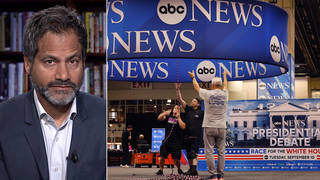
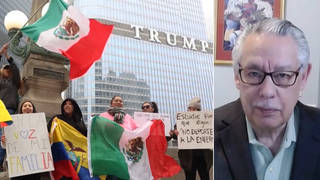
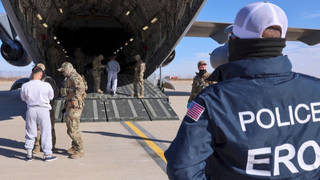
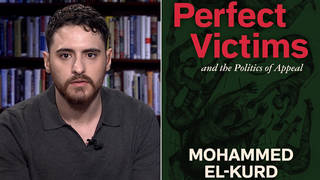
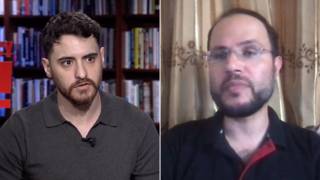
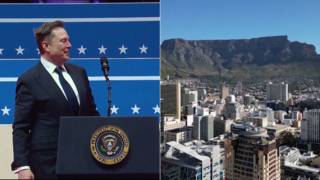
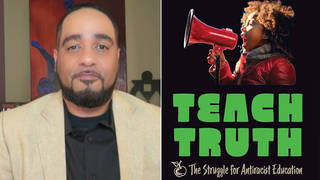
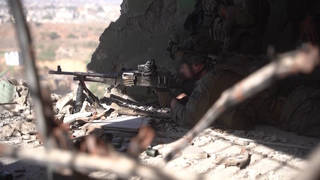

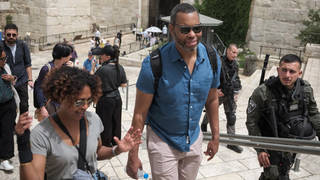
Media Options